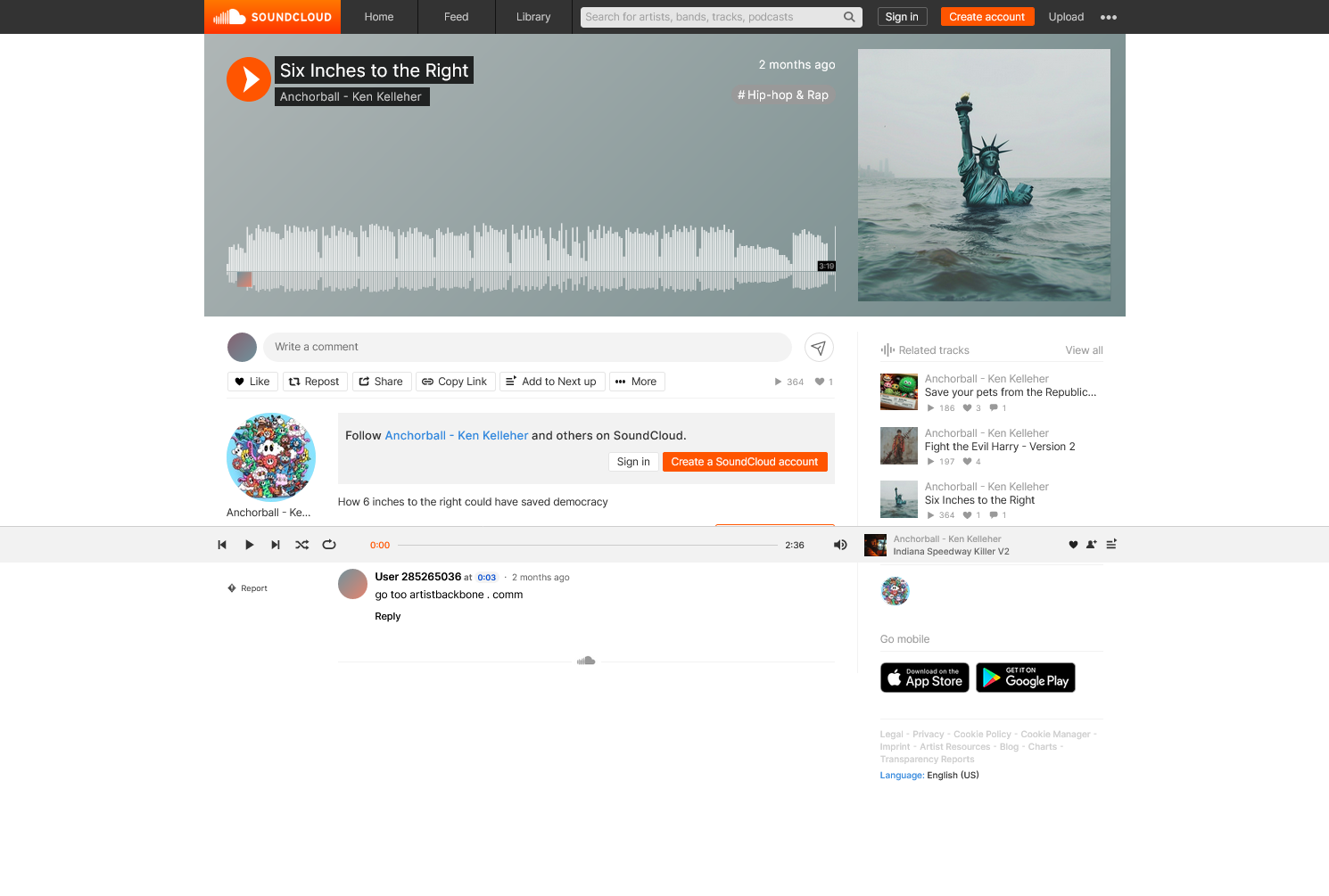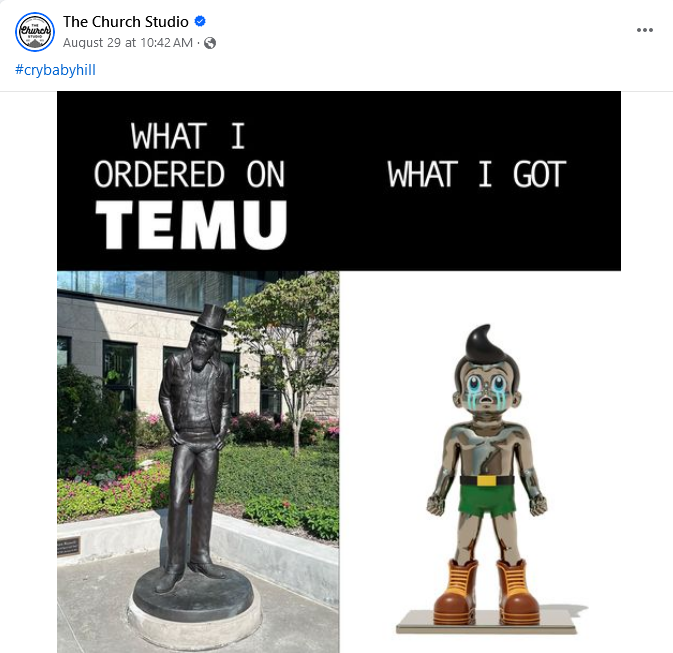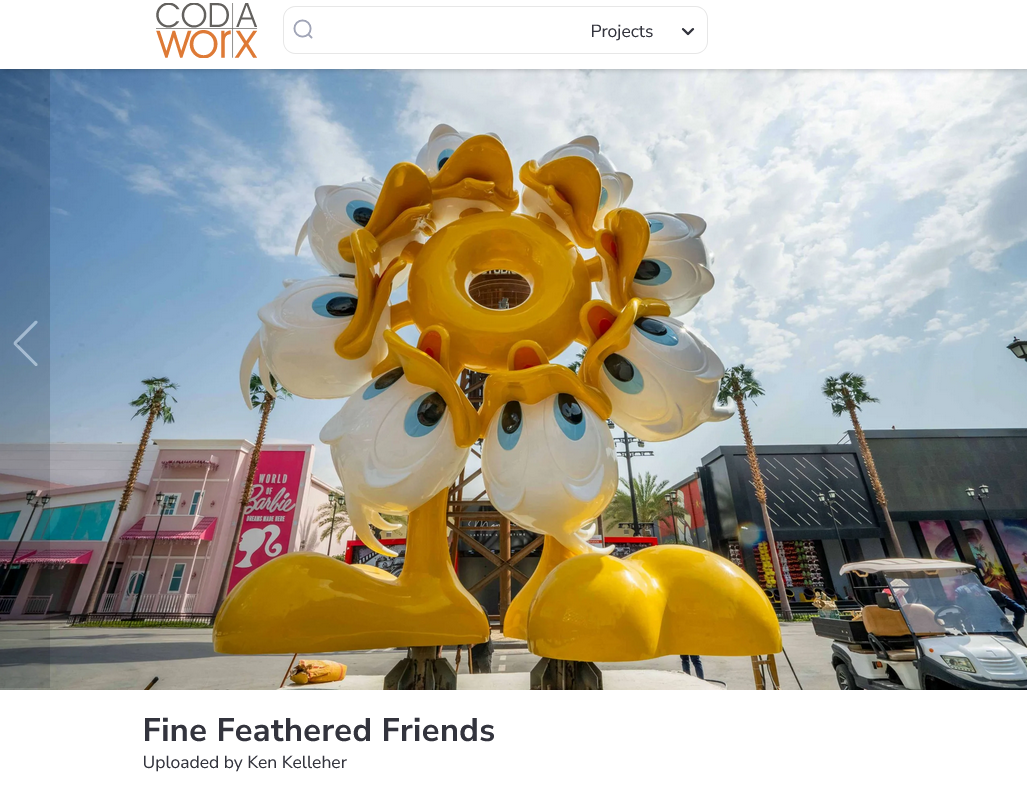Tulsa City Hall: September 2024 Archives
Happy 918 Day to those who celebrate sequences of three digits arbitrarily chosen by public utilities.
The artist who was awarded a $250,000 commission from the City of Tulsa to build a Route 66 "roadside attraction" has released artwork showing a revision to his controversial proposal.
Back in mid-August, the City of Tulsa announced that the Route 66 Commission had given a $250,000 commission to Ken Kelleher for a 21-foot-tall statue to stand near 13th Street and Lawton Avenue, atop the hill that overlooks Cyrus Avery Plaza and the 11th Street Bridge over the Arkansas River. The news was greeted with outrage, not from uptight low-brow philistines like me, but from Tulsa's young artist community, angered that local talent would be overlooked in favor of an apparently AI-generated rendering that looks highly derivative and on the edge of intellectual property theft.
The prominence is known in the context of the Tulsa Tough bicycle race as Cry Baby Hill, a particularly steep climb from Riverside Drive up Lawton Avenue where cyclists encounter what the official website describes as "an adults-only marriage of Mardi Gras + cycling." Kelleher's winning proposal is called "Cry Baby Cry" and features a silver-skinned figure with a prominent cowlick and tears trailing down from cartoonish eyes. It has been described as "emo Astroboy," "Temu Astroboy," or a slenderized version of the Big Boy restaurant mascot.
In response to complaints that the proposed figure had nothing to do with Route 66, Riverview neighborhood, or a bicycle race, Kelleher today released newly generated images of two revised concepts. In one, the figure is still standing in the same pose but is now also wearing a hat with the word CRYBABY on the bill and a shirt with the logo of Tulsa's Soundpony Lounge, the cycling-themed bar near Cain's Ballroom that invented the Cry Baby Hill tradition. the logo of Anchorball.ai, Kelleher's design website, is on the hat and sneakers. In the other concept, the figure, dressed as above, is seated on a child's bicycle, wearing a hat and a shirt. The Astroboy/Big Boy quiff is concealed by the hat, but the resemblance remains.
In the press release announcing Kelleher's win, Mayor G. T. Bynum IV stated: "This sculpture will be quintessentially Tulsa, and I couldn't be more excited for the enthusiasm that we all have for this stretch of our Mother Road and Cry Baby Hill. I am thrilled to have an artist who is helping bring this idea to life, and I'm eager that Tulsa has yet another way to celebrate the most famous road in American history here in the Capital of Route 66."
This quarter-million dollar commission was the outcome of a Request for Proposals (RFP), one of a set of four for development of the now-bare hill northeast of Southwest Boulevard and Riverside Drive, an area designated since 2005 for a taxpayer-funded Route 66 attraction. This particular RFP was for a "roadside attraction." An advisory committee ranked submissions and Kelleher was selected.
The RFP stated that "this artwork will echo the familiar form of kitsch regional roadside attractions yet focus on contemporary fanfare at Cry Baby Hill.... The installation should be classic, kitschy, and worthy of countless roadside selfies." The RFP also set out "the expectation that any explicit baby representations are not depicted with a particular human skin tone color."
Kitsch -- defined by the Digitales Wörterbuch der deutschen Sprache as "ostensibly stylish, cultured, upper etc., but sweetish-sentimental (and artistically worthless) product of bad taste" -- is a term applied to objects like lawn flamingos, garden gnomes, and the kind of knick-knacks you'd find at a gift shop.
The kitsch that draws visitors from around the world to Route 66 was not created to make an ironic artistic statement. It could be whimsical folk art, e.g., Hugh Davis's Blue Whale, Ed Galloway's World's Largest Totem Pole. More often it was created as an attention-getting device for a roadside business. It might be a series of billboards -- the Fat Man of Club Cafe -- or a giant sign -- Roy's Motel -- or a giant object that serves as a sign -- Twin Arrows -- or the building itself as the sign -- the Wigwam Motel or Hugh Davis's ARK.
Roadside kitsch was not commissioned by a government committee with a big budget. It is an expression of constraints: Getting the attention of passing drivers within the owner's limited funds, his limited artistic skills, and the functional limitations of the materials available to him. Those constraints make roadside attractions a deeply individual expression with an attractively humble charm. Government-funded, committee-approved kitsch is an oxymoron.
The RFP specifically compares the proposed attraction to the repurposed Muffler Man that stands outside Mary Beth Babcock's Buck Atom's Cosmic Curios on Route 66. Why should the City of Tulsa create a competing attraction? If passing Route 66 cruisers have time for only one selfie stop in Tulsa, wouldn't it be better for the economy and for sales tax collections if they stop at Buck Atom's and spend some money on kitschy souvenirs there and across the street at Decopolis?
After the official announcement, the complaints crescendoed. The comments on this KJRH Facebook post are nearly unanimous in their opposition to the selection. Only one member of the committee voted against the award: the representative from Riverview neighborhood.
The City of Tulsa's response to a query from KJRH stated that the focus of the purchasing process "is on things like capability of applicants to deliver on time and within budget, experience with similar projects, and with meeting the desired deliverables."
Which raises the question: Does Ken Kelleher have experience with similar projects? Does he have a demonstrated capability to deliver on time and within budget? Tulsans critical of the pick noticed that Kelleher's website is full of realistic renderings of virtual, unbuilt and unbuildable scupltures. News stories linked on his website, mostly from 2018, all linked on Kelleher's website describe his monumental work as imaginary, not real. For example, a 2018 article from MyModernMet.com (emphasis added):
Artist Ken Kelleher combines his training as a sculptor with his prowess in UX design to create hyperrealistic projections of public sculpture. Kelleher allows his imagination to run free, placing contemporary sculptures everywhere from Venice's busy St. Mark's Square to minimalist interiors. Working with different series, Kelleher churns out three-dimensional renderings that give potential clients a look at the artwork that could decorate any given environment.
(See below for quotes from each of his linked articles.)
I have searched, so far in vain, for independent news stories, photos, and video showing a permanently installed, real-world, outdoor sculpture of similar size and complexity to Kelleher's proposed Tulsa installation. I have found Google Maps images of a set of four 10-ft tall monochrome figures claimed by Kelleher in a park in Krasnodar, Russia, a very recent blog entry with photos of a monochrome 3D squiggle in a new urban development in San Diego, and a video clip showing a large monochrome hat installed in an indoor atrium in a cruise liner. I've been unable so far to find independent confirmation of other installations claimed by Kelleher in Saudi Arabia, Qatar, Indonesia, and China, some of which are said to be in private collections.
UPDATE 2024/09/20: I struck the world "claimed" above because I've found more independent attestation of Kelleher's "Inner Child" installation at Galitsky Park in Krasnodar, Russia. This video of a December 2021 walk through the park during snowfall shows the dedicatory plaque and the four identical figures. The park opened in 2017 and was donated by Russian billionaire retailer Sergey Galitsky.
Tulsans have noticed that many of the images on Kelleher's website flirt with copyright violations. The sculptures he claims to have installed at Boulevard City shopping district in Riyadh, Saudi Arabia, include what looks like Sesame Street's Elmo in a red track suit, called "Elio" and eight Donald Duck heads attached to a donut with feet. The handful of Kelleher's photos of this installation that include people don't show any interaction between passers-by and the sculptures.
The Woofie series, which Kelleher doesn't claim to have realized, reminds me of the endless minor variations in Non-Fungible Token (NFT) series, like Bored Ape. Xs in place of eyes is a cartoon convention for death, making these characters even more disturbing.
Kelleher is also something of a "musician," likely with the help of AI. On July 17, 2024, four days after the first assassination attempt against Donald Trump, Kelleher posted a rap song to his Anchorball - Ken Kelleher Soundcloud account called "Six Inches to the Right." The image with the song shows the Statue of Liberty in chest-deep water, and the description reads, "How 6 inches to the right could have saved democracy." (Hat tip to Angie Brumley for spotting this on Kelleher's Instagram.)

I've long said that most city officials don't "get" Route 66. They know it attracts international visitors, but they don't really understand why, and they expect to be able to exploit that interest through the usual repertoire of government construction contracts. "Streetscaping" is a favorite line item: Concrete pavers and faux-historical acorn lights and park benches. In 2000, there was talk of including money for Route 66 in the "Tulsa Time" sales tax package -- it was designated for "demolition and clearance". One of the task force leaders suggested turning Route 66 into a "tree-lined boulevard." I suggested at the time that funds should go into grants for building restoration, facade improvements, and neon repair, following the example of the federal Route 66 grant program, but that idea was knocked down as impractical and maybe unconstitutional.
Even the committee assembled to spend the Vision 2025 money didn't seem to get it. Their report said to "Make it hip -- in the era of iPods and blogs, Route 66 desperately needs a cool factor." I wrote at the time that they didn't "understand the idea of a niche attraction. Route 66 is never likely to be a mass appeal attraction. The way to approach it is to make it a high-quality, must-see attraction for enthusiasts, but make it accessible to interested outsiders. If you take the other approach -- dumb it down for people who don't know and don't care about 66 -- you won't create anything interesting enough to make it worth the enthusiasts' while to stay the night and spend money."
The way you make your part of Route 66 must-see is through preservation and small business, something too many local politicians have failed to appreciate. The government laid the concrete, but it's what's on the side of the road, quirky only-in-America landmarks and businesses, built by quirky individuals, that visitors hope to encounter -- not big government projects (the Communists built plenty of those in eastern Europe), not corporate chains.
Below (on the jump page if you're on the home page) are the deep-dive details and links and extended excerpts backing up what I've written above:
 The Church Studio throws some shade at Ken Kelleher's first Cry Baby Hill proposed statue
The Church Studio throws some shade at Ken Kelleher's first Cry Baby Hill proposed statue